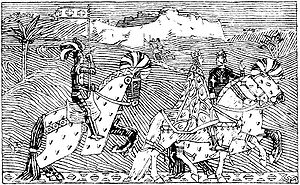Siege of Sidon
| Siege of Sidon | |||||||||
|---|---|---|---|---|---|---|---|---|---|
| Part of the Norwegian Crusade | |||||||||
 King Sigurd and King Baldwin ride from Jerusalem to the river Jordan by Gerhard Munthe. | |||||||||
| |||||||||
| Belligerents | |||||||||
| Fatimid Caliphate | |||||||||
| Commanders and leaders | |||||||||
| Governor of Sidon[1] | |||||||||
| Strength | |||||||||
|
Franks
Venetians
|
Fatimids
| ||||||||
| Casualties and losses | |||||||||
| unknown, but probably minor | unknown, but probably large | ||||||||
The Siege of Sidon was an event in the aftermath of the First Crusade. The coastal city of Sidon was captured by the forces of Baldwin I of Jerusalem and Sigurd I of Norway, with assistance from the Ordelafo Faliero, Doge of Venice.
Background
In the summer of 1110 a Norwegian fleet of 60 ships arrived in the Levant under the command of King Sigurd. Arriving in Acre he was received by Baldwin I, King of Jerusalem. Together they made a journey to the river Jordan, after which Baldwin asked for help in capturing Muslim-held ports on the coast. Sigurd's answer was that "they had come for the purpose of devoting themselves to the service of Christ", and accompanied him to take the city of Sidon, which had been re-fortified by the Fatimids in 1098.
The siege
Baldwin's army besieged the city by land, while the Norwegian came by sea. A naval force was needed to prevent assistance from the Fatimid fleet at Tyre. Repelling it was however only made possible with the fortunate arrival of a Venetian fleet. The city fell after 47 days.
The Icelandic skald Einarr Skúlason gives the following account.
|
|
Aftermath
By order of Baldwin and the Patriarch of Jerusalem, Ghibbelin of Arles, a splinter was taken off the holy cross and given to Sigurd.
The Lordship of Sidon was created and given to Eustace Grenier, later a constable of the Kingdom of Jerusalem.
References
- ^ The Fatimids would very often leave the responsibility of defending a city in the hands of a governor, as they did when Jerusalem was taken by the crusaders.
- ^ Store norske leksikon - Sigurd 1 Magnusson Jorsalfare – utdypning (NBL-artikkel)
Sources
- Battles and sieges, Tony Jaques
- The Crusades and the expansion of Catholic Christendom, 1000-1714, John France
- The Second Crusade, Jonathan Phillips
- The chronicle of Ibn al-Athīr for the crusading period from al-Kāmil fīʼl-taʼrīkh, ʻIzz al-Dīn Ibn al-Athīr and Donald Sidney
- Saga of Sigurd the Crusader and His Brothers Eystein and Olaf
